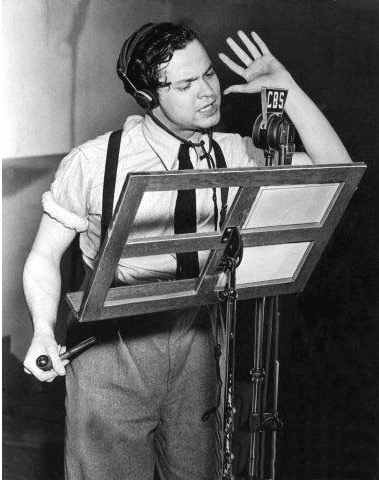 Invading Martians land in New Jersey’s meadowlands, their fighting machines marching toward Manhattan. New Yorkers flee in terror because of some golden-age radio storyselling.
Invading Martians land in New Jersey’s meadowlands, their fighting machines marching toward Manhattan. New Yorkers flee in terror because of some golden-age radio storyselling.
Orson Welles’ Mercury Theater of the Air’s War of The Worlds demonstrates not only the compelling nature of radio, but the power of storytelling itself. That 1938 radio play also revealed to me how to build traffic for web videos.
Whether it’s on the radio, in a magazine, or across the web, the secret sauce of success is story. A story well told stirs action, gets remembered, and passed along. The difference between getting a dozen views and attaining multi-bazillion viral status comes down to story.
Our web videos were holding viewers for about 70-80% of their 90-second length—which is actually above average. Typically, web videos lose 75% of viewers in the first 30 seconds. However, after instituting the story model I’m about to share with you, our viewership ballooned out to 95-100% while total views lifted 38%. Storyselling made the difference.
Storytelling vs Storyselling
The dividing line between a bedtime story and one that keeps you awake is storyselling. Orson Welles’ description of peering down into the darkness at a Martian landing craft dug deep in the earth, sold listeners. A great singer sells a song. Sermons sell an idea—videos should too.
A snowstorm of facts isn’t storytelling. Facts don’t sell. Same goes for a wandering narrative of corporate talking points. Facts typically weigh a story down. Stories are about ideas.
Stories live between what is real and what the consumer wishes were real. Effective stories connect those realities across a relatable arc of intrigue, surprise, and delight. Creating that compelling, persuasive arc, I discovered, is a matter of asking the right questions.
My 1-2-3 of persuasive storyselling
Whether creating an ad, developing content, or producing a video, our projects start with these three questions:
1. What is the story about?
2. Where will it take the consumer?
3. How does it change their lives?
Three dimensions of story
Answering each question from the consumer’s point of view keeps a story on course:
1) Topic: The degree of story relevance determines interest.
2) Transport: Its movement from start to finish holds attention.
3) Touch: Its impact on the consumer’s life measures your story’s persuasive power.
Take any one away, and you got zip.
Story creates handles
Remember those ads I created for the remodeling contractor recently? He probably could have described projects more thoroughly, but nowhere near as persuasively as his story did.
Combining storyselling’s three dimensions endows your tale with naturally occurring persuasive power. In this age of disposable messages, even if it’s only just remembered, a story accomplishes a great deal. Story creates handles for easy carrying.
Your first step
AM radio and storytelling technology have changed very little since Orson Welles apologized after he “annihilated the world before your very ears and utterly destroyed the Columbia Broadcasting System.”
As we become more sophisticated, jaded consumers, the power of story only becomes more effective. Storyselling’s transformational capacity to make your content memorable, transferable, and actionable means developing a well-crafted story is your first step in creating effective messaging.
BTW: If you have an hour, click on the image of Orson Welles to hear the full War of The Worlds broadcast. It’s best enjoyed without interruption in a darkened room.
- Lessons In Being A More Interested Human from ChatGPT - October 2, 2025
- Investing effort vs. spending time - March 17, 2025
- Play angle of approach for fun and profit - February 14, 2025
